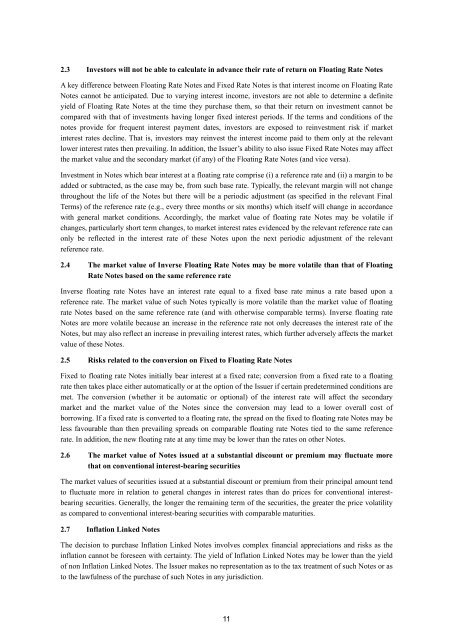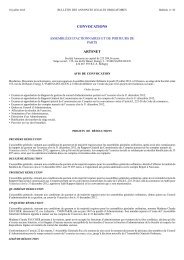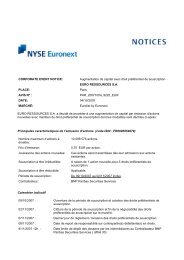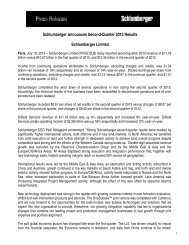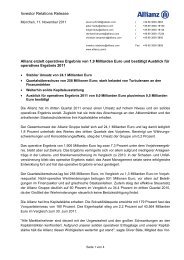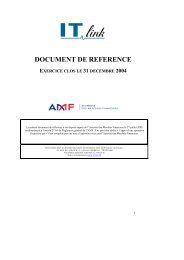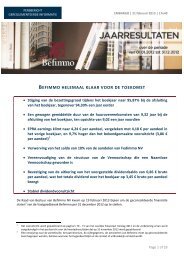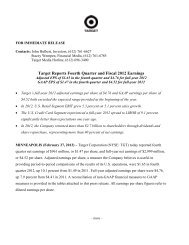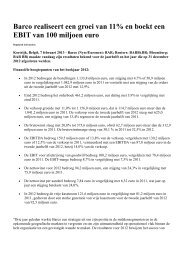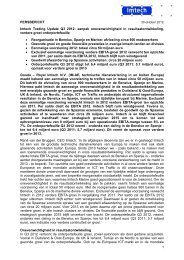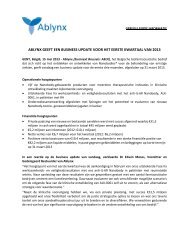Euro 6,000,000,000 Euro Medium Term Note Programme Due from ...
Euro 6,000,000,000 Euro Medium Term Note Programme Due from ...
Euro 6,000,000,000 Euro Medium Term Note Programme Due from ...
You also want an ePaper? Increase the reach of your titles
YUMPU automatically turns print PDFs into web optimized ePapers that Google loves.
2.3 Investors will not be able to calculate in advance their rate of return on Floating Rate <strong>Note</strong>s<br />
A key difference between Floating Rate <strong>Note</strong>s and Fixed Rate <strong>Note</strong>s is that interest income on Floating Rate<br />
<strong>Note</strong>s cannot be anticipated. <strong>Due</strong> to varying interest income, investors are not able to determine a definite<br />
yield of Floating Rate <strong>Note</strong>s at the time they purchase them, so that their return on investment cannot be<br />
compared with that of investments having longer fixed interest periods. If the terms and conditions of the<br />
notes provide for frequent interest payment dates, investors are exposed to reinvestment risk if market<br />
interest rates decline. That is, investors may reinvest the interest income paid to them only at the relevant<br />
lower interest rates then prevailing. In addition, the Issuer’s ability to also issue Fixed Rate <strong>Note</strong>s may affect<br />
the market value and the secondary market (if any) of the Floating Rate <strong>Note</strong>s (and vice versa).<br />
Investment in <strong>Note</strong>s which bear interest at a floating rate comprise (i) a reference rate and (ii) a margin to be<br />
added or subtracted, as the case may be, <strong>from</strong> such base rate. Typically, the relevant margin will not change<br />
throughout the life of the <strong>Note</strong>s but there will be a periodic adjustment (as specified in the relevant Final<br />
<strong>Term</strong>s) of the reference rate (e.g., every three months or six months) which itself will change in accordance<br />
with general market conditions. Accordingly, the market value of floating rate <strong>Note</strong>s may be volatile if<br />
changes, particularly short term changes, to market interest rates evidenced by the relevant reference rate can<br />
only be reflected in the interest rate of these <strong>Note</strong>s upon the next periodic adjustment of the relevant<br />
reference rate.<br />
2.4 The market value of Inverse Floating Rate <strong>Note</strong>s may be more volatile than that of Floating<br />
Rate <strong>Note</strong>s based on the same reference rate<br />
Inverse floating rate <strong>Note</strong>s have an interest rate equal to a fixed base rate minus a rate based upon a<br />
reference rate. The market value of such <strong>Note</strong>s typically is more volatile than the market value of floating<br />
rate <strong>Note</strong>s based on the same reference rate (and with otherwise comparable terms). Inverse floating rate<br />
<strong>Note</strong>s are more volatile because an increase in the reference rate not only decreases the interest rate of the<br />
<strong>Note</strong>s, but may also reflect an increase in prevailing interest rates, which further adversely affects the market<br />
value of these <strong>Note</strong>s.<br />
2.5 Risks related to the conversion on Fixed to Floating Rate <strong>Note</strong>s<br />
Fixed to floating rate <strong>Note</strong>s initially bear interest at a fixed rate; conversion <strong>from</strong> a fixed rate to a floating<br />
rate then takes place either automatically or at the option of the Issuer if certain predetermined conditions are<br />
met. The conversion (whether it be automatic or optional) of the interest rate will affect the secondary<br />
market and the market value of the <strong>Note</strong>s since the conversion may lead to a lower overall cost of<br />
borrowing. If a fixed rate is converted to a floating rate, the spread on the fixed to floating rate <strong>Note</strong>s may be<br />
less favourable than then prevailing spreads on comparable floating rate <strong>Note</strong>s tied to the same reference<br />
rate. In addition, the new floating rate at any time may be lower than the rates on other <strong>Note</strong>s.<br />
2.6 The market value of <strong>Note</strong>s issued at a substantial discount or premium may fluctuate more<br />
that on conventional interest-bearing securities<br />
The market values of securities issued at a substantial discount or premium <strong>from</strong> their principal amount tend<br />
to fluctuate more in relation to general changes in interest rates than do prices for conventional interestbearing<br />
securities. Generally, the longer the remaining term of the securities, the greater the price volatility<br />
as compared to conventional interest-bearing securities with comparable maturities.<br />
2.7 Inflation Linked <strong>Note</strong>s<br />
The decision to purchase Inflation Linked <strong>Note</strong>s involves complex financial appreciations and risks as the<br />
inflation cannot be foreseen with certainty. The yield of Inflation Linked <strong>Note</strong>s may be lower than the yield<br />
of non Inflation Linked <strong>Note</strong>s. The Issuer makes no representation as to the tax treatment of such <strong>Note</strong>s or as<br />
to the lawfulness of the purchase of such <strong>Note</strong>s in any jurisdiction.<br />
11


